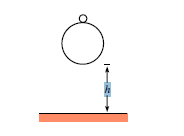Basketball and tennis ball: Part I
 A tennis ball with (small) mass
m2
sits on top of a basketball with (large)
mass
m1
. The bottom of the basketball is a height
h
above the ground, and
the bottom of the tennis ball is a height
h + d
above the ground. The balls
are dropped. To what height does the tennis ball bounce?
A tennis ball with (small) mass
m2
sits on top of a basketball with (large)
mass
m1
. The bottom of the basketball is a height
h
above the ground, and
the bottom of the tennis ball is a height
h + d
above the ground. The balls
are dropped. To what height does the tennis ball bounce?
Note: Work in the approximation where m1 is much larger than m2 , and assume that the balls bounce elastically.
This is a part of the 'Harvard Problem of the Week' set. Go on and try out the whole bunch of them.
This section requires Javascript.
You are seeing this because something didn't load right. We suggest you, (a) try
refreshing the page, (b) enabling javascript if it is disabled on your browser and,
finally, (c)
loading the
non-javascript version of this page
. We're sorry about the hassle.
For this case:
Let v 1 and v 2 the final velocities of the basketball ball and tennis ball respectively. Same convention for masses m 1 and m 2 .
Air resistance is negligible
The origin for the frame of reference is height h
Since the balls fall from rest, the time required to fall to a height h is
2 1 g t 2 = h ∴ t = g 2 h
Therefore the velocity for both balls is
v = g t = g g 2 h = 2 g h
When the basketball ball reaches the ground, both balls have a velocity − v , when the same ball ( the basketball one) bounces off the ground, for an instant, the basketball ball goes with a velocity v meanwhile the tennis ball goes with a velocity − v . As the collision is elastic, momentum and kinetic energy are conserved, this gives us two equations
m 1 v − m 2 v = m 1 v 1 + m 2 v 2 . . . . . . . . . . . . . . . . . ( 1 )
m 1 v 2 + m 2 v 2 = m 1 v 1 2 + m 2 v 2 2 . . . . . . . . . . . . . . . . . . . . . ( 2 )
The goal here is to find v 2 , according to (1)
v 1 = m 1 v ( m 1 − m 2 ) − m 2 v 2 . . . . . . . . . . . . . . . . . . . . . ( 3 )
Substitute (3) in (2)
m 1 v 2 + m 2 v 2 = m 1 ( m 1 v ( m 1 − m 2 ) − m 2 v 2 ) 2 + m 2 v 2
Solving this equality for v 2 results in this quadratic equation
( m 1 + m 2 ) v 2 2 − 2 v ( m 1 + m 2 ) v 2 + ( m 2 − 3 m 1 ) v 2 = 0
Solving that equation
v 2 = 2 ( m 1 + m 2 ) 2 v ( m 1 + m 2 ) ± 4 v 2 ( m 1 + m 2 ) 2 − 4 v 2 ( m 1 + m 2 ) ( m 2 − 3 m 1 ) = m 1 + m 2 v ( m 1 + m 2 ) ± v ( m 1 + m 2 ) ( 4 m 1 ) = m 1 + m 2 v ( m 1 + m 2 ) ± 2 v ( m 1 + m 2 ) m 1
v 2 = v ± 2 v m 1 + m 2 m 1 = v ( 1 ± 2 m 1 + m 2 m 1 )
As m 1 > m 2
v 2 = v ( 1 + 2 m 1 + m 2 m 1 )
If m 1 > > m 2 , then m 1 + m 2 m 1 approaches 1 and v 2 approaches 3 v . With this, after the bounce, the tennis ball will follow this equation about its height
h ( t ) = − 2 1 g t 2 + 3 v t + d
its maximum height is reached when t = g 3 v (see this for more information), with this
h m a x = − 2 1 g ∗ g 2 9 v 2 + 3 v ∗ g 3 v + d = 2 1 ( g 9 v 2 ) + d = 2 1 ( g 9 ∗ 2 g h ) + d = 9 h + d